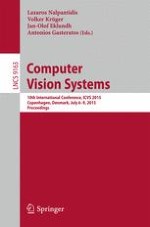2015 | Buch
Computer Vision Systems
10th International Conference, ICVS 2015, Copenhagen, Denmark, July 6-9, 2015, Proceedings
herausgegeben von: Lazaros Nalpantidis, Volker Krüger, Jan-Olof Eklundh, Antonios Gasteratos
Verlag: Springer International Publishing
Buchreihe : Lecture Notes in Computer Science
